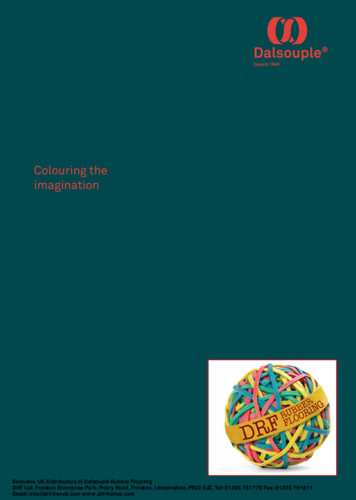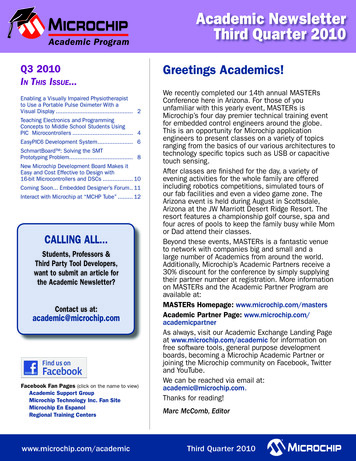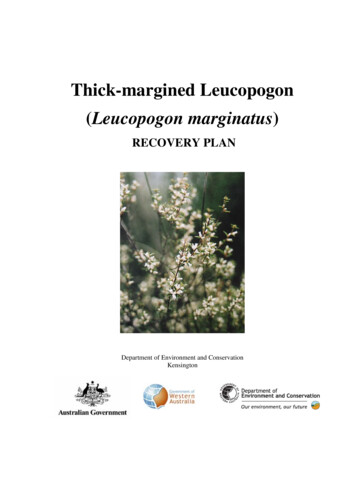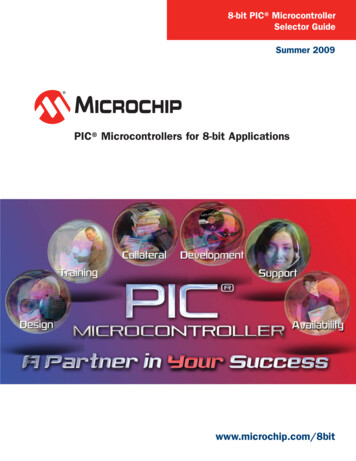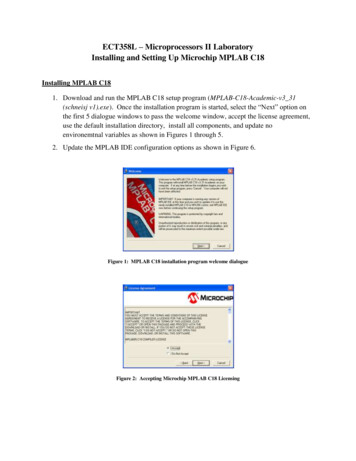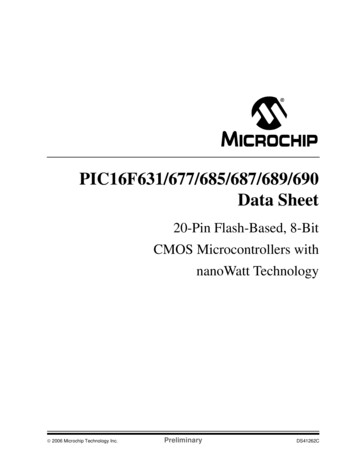
Transcription
Application Note 1815May 2013DRF Series Design GuideGeorge J. KrausseMicrosemi Corp RF Power Products Group405 SW Columbia St.Bend, OR 97702 USAgkrausse@microsemi.comDick FreyMicrosemi Corp RF Power Products Group405 SW Columbia St.Bend, OR 97702 USAdfrey@microsemi.comIntroductionIn this Design Guide we will detail the design process involved when using the DRF Series of devices and theirperformance. As we move through this document it will be necessary to clearly define and explain multipletechnical points so that we have a mutual understanding of the key issues and how to address them. The DRF Seriesis based on a Flangeless Mechanical design illustrated in Figure 1. All of these devices incorporate at least onedriver die, the DRF100; all others have one or two driver die and one or two MOSFET semiDRF1300MicrosemiDRF140012345678910 11 12 1314DRF100DRF1200DRF1300DRF1400Driver Test Deviceand Die QualificationpackageSingle EndedPush-PullHalf-BridgeDriver and 1 HVMOSFET2 Driver and 2 HVMOSFETs2 Driver and 2 HVMOSFETsFigure 1. DRF Series DevicesThe DRF100 was the platform used to develop and qualify the RF Driver IC. Understanding the design, layout andfunction of the DRF100 is necessary to appropriately understand the DRF family of devices. The DRF devices arecapable of multiple Kilowatts at RF Frequencies of 2MHz to 30MHz; the DRF1200 Series 1KW; the DRF1300Series 1-2KW; and the DRF1400 Series 2-3KW.www.microsemi.com1/32
Application Note 1815May 2013DRF100C1U1Figure 2. Simplified DRF100 Circuit DiagramFN owLowHighTable 1InvertingThe simplified DRF100 Circuit Diagram isillustrated in Figure 2 above. By including the high speed by-pass capacitor, the contribution to the internal parasiticloop inductance of the driver output is greatly reduced. This low parasitic approach, coupled with the SchmittTrigger input (pin 4), Kelvin Signal Ground (pin 5) and the Anti-Ring Function, provide improved stability andcontrol. The IN pin (4) is applied to a Schmitt Trigger. The signal is then applied to the intermediate drivers andlevel shifters; this section contains proprietary circuitry designed specifically for ring abatement. The P channel andN channel power drivers provide the high current to the Output (pin 9). Table 1 is the truth table for the DRF100.ElectricalMOSFET Model and ParasiticsThe DRF100 is a High-Speed Power RF MOSFET driver. It is intended to drive the gate of a power RF MOSFETwith 3nF gate capacitance to 15V at frequencies up to 30MHz. It can produce output currents 8A RMS, whiledissipating 60W. The Driver output can be configured as Inverting or Non-Inverting.To understand the driver and its integration into a power RF package with a power MOSFET, it will be useful toreview the important design considerations in that process. The Driver circuit model is illustrated in Figure 3.V1R1.151L1.15n2V33C12.5nV14R2.35R1 represents the on resistance of the internal MOSFETs in the outputsection of the Driver. This parameter is driven by driver performancerequirements. L1 accounts for Loop Inductance in the driver output. C1models the effective output capacitance of the driver and R2 is the ESR ofC1. V1 provides the control signal.(Node 0)Figure 3. Driver Circuit Modelwww.microsemi.com2/32
Application Note 1815May 2013CNET CISS CRSS ( VDS VGS) VGSMiller CapacitanceNegative FeedbackLD is a Small valueand Most Often hasLittle Effect on DevicePerformanceSource InductanceNegative FeedbackLG and RG Limit BandwidthVLS LS didtMOSFET MODELFigure 4. Negative Feedback TermsThere are two significant Negative Feedback Terms that affect MOSFET performance, the DRF100, and all theDRF devices. They are the effect of Miller Capacitance (CNET) and Source Lead Inductance (VLS). Figure 4shows the location of these two Negative Feedback Terms and the equations that describe their effects on MOSFETsand the DRF Series Devices. We have little control over the CNET term; however we can ensure, by design, that theDriver IC has sufficient output voltage swing and power margin to drive all the RF MOSFETs we may choose touse. In addition we have taken great care to minimize the VLS and LG terms in all of the DRF Devices. LG and RGimpact Bandwidth and switching speed. LD in most DRF devices is between 5 and 15nH in the Drain circuit. Thishas very little effect on most circuits operating below 50MHz.Referring to Figure 4, as the current rises in the MOSFET at turn on, the Voltage at Node 3, MOSFET Source (Die)also rises. This is a negative feedback term to the Gate Drive at Node 2. The magnitude is driven by the insetequation for (VLS).At the same time, the voltage at the Drain (Die), Node 1, falls. This falling voltage produces a negative feedbackterm to the Gate (Die) Node. The magnitude of this “Miller Feedback” is given by the inset formula (CNET). In shortit presents an increase in effective input capacitance which is voltage and time dependent. The time dependency isdetermined by the rate of change of the drain voltage.Miller Capacitance is a function of Silicon Die design - the bigger the die, the larger the Miller effect. The Source,Gate and Drain lead inductance are byproducts of the geometry of the package design.As we integrate Figure 3 and Figure 4 into a Hybrid, we cross from the discreet components, as illustrated in Figure4, to a multi-chip module design. In that process it is important to minimize all parameters that will limitperformance of the hybrid.www.microsemi.com3/32
Application Note 1815May 2013Loop InductanceLOADThis section discusses how package inductance and circuit strayinductance are formed, and how to minimize them.The parasitic loop for an RF Output is schematically illustrated inFigure 5. The Source V1 is the square wave output to the RF Networkand the load. The mechanical geometry forms a current loop that isvery critical to Circuit Operation. The smaller the loop, the lower thestray inductance.W -Figure 5. Current Loop in an RF LoopΔ B Field Excluded from metal planeCrossSectionalAreaΔ CurrentV1B Field can only form in theopen area, A.WL Δ B FieldB FieldFigure 6. Loop Inductanceµo N2 AWCurrent flowing in the metalsheetFigure 7. Loop InductanceFigures 6 and 7 illustrate the output loop inductance of an RF Power Output Stage. From Equation 1 we see that thestray inductive term is directly proportional to the Cross Sectional Area. Therefore, if we minimize the CrossSectional Area we will reduce the loop inductance proportionally. In addition, if we increase the width W we willalso reduce the Loop Inductance. See the equation below.Equation 1μ N 2AL 0WWhere:L Inductance, Hµ0 Permeability of Free Space, 1.26 x 10-6 H m-1N2 (Number of turns)2 1A Cross Sectional Area, m2W Width, mEquation 1 shown at the left is simplified but accurateenough for our discussion. Looking at this equation, wesee the only two terms that we can change are terms Aand W. See Equation 2. In the process of Printed Circuitdesign it is essential that A/W is minimized in order tooptimize circuit Performance.Equation 2L:AWFor the RF Output Section this loop inductance is a very critical, geometry and layout-driven, parameter. Thesmaller the better. This lower inductance drives the ring frequency higher with lower amplitude. If the loopinductance is too large ringing on the top of the Drain voltage waveform can have severe consequences, such as HVbreakdown, reduced power output, higher harmonics and loss of stability. The PCB layout must incorporate thisunderstanding. This will be discussed in more detail later in the Hybrid section and in the Push-Pull and Half-Bridgesections.www.microsemi.com4/32
Application Note 1815May 2013MechanicalThe DRF family of RF Hybrid Devices incorporates one or two RF Driver Integrated Circuits and one or two RFPower MOSFETs. The DRF Series devices are designed to allow their user to focus on the Output RF elements inthe design with little need to address the RF Driver. For this discussion we will start with the Flangeless DiscreteDevices. Figure 8 illustrates the construction of the Legacy Devices and the New Flangeless devices. The principalphysical difference between the two, is the Copper Tungsten Flange, used on legacy devices. This leads to adifference in the Thermal Impedance, Power Cycle Capability as well as Electrical and RF performance. There isalso the cost differential between the two technologies.Mounting Holes arelocated in the LidFiberglass reinforcedPlastic Lid. Ultem2300Ceramic LidRF Die.010in. goldplated Kovarlead frame.005in. Coppergold platedlead frameRF DieBeOSubstrateRefractory LeadFrame AttachBeOSubstrateCopperTungsten FlangeRefractorySubstrateAttachMounting Holesare located inthe FlangeLegacy DeviceFlangeless DeviceFigure 8. Legacy and New Flangeless Construction4-40 Screw 4-6 in./lbSplit Ring /Belleville WasherRF DieCompressiveForce.005in. BossBeO SUBSTRATEHEAT SINKThermal CompoundDevice LeadFigure 9. Flangeless Power DeviceCompressionLid Ultem 2300In Figure 8 we see both theFlangeless and the legacy Flangeddevice. There are only threeobvious components that theyshare: the lead frame, the die andthe substrate. The compressionmechanics of the package designare less obvious. Referring toFigure 9, when the two 4-40 screwsare tightened, the 0.005in. Bossesat the two ends of the package lid,force the package to flex.These Bosses contact the heat sink first. As torque is applied to the mounting screws, the lid begins to flex and in sodoing applies a constant pressure to the substrate, pressing it hard onto the heat sink. The two green arrows in Figure9 illustrate this pressure. The side walls of the plastic lid have been removed in this sectioned view of the package.The side walls are thick and tall so that the pressure applied along the complete perimeter of the BeO substrate isclose to the same. The lid is constructed with a fiberglass reinforced plastic, Ultem 2300, an exceedingly strong hightemperature material.www.microsemi.com5/32
Application Note 1815May 2013ThermalFigure 10 illustrates the VRF154 Thermal Profile and Figure 11 the MRF154, a flanged device with similarmechanical construction. The Thermal Profile illustrates one of the differences between the Flangeless and theFlanged device. They both start at 25 C and end at 175 C, however it is the point-by-point delta in these two plotsas they move between limits that illustrates the different in the specific heat of the packages.2251 Die2 Solder3 Metal 14 BeO5 Metal 26 Thermal Compound7 Heat Sink Surface200175150Tj225Chart jDELTA T THS( TJ THS)PD: Rθ JHS3PD 1. 782 10RθJC 0. 052PD: 014jDELTA T THS( TJ THS)Rθ JHS23VRF154Figure 12. VRF154VRF154RθJC .06RθJHS .193PD 908WPDC 1.23KW63PD 1.601 10Rθ JHS 0. 084Figure 10. VRF154 Thermal Profile578RθJC 0. 036Rθ JHS 0. 094Figure 11. MRF154 Thermal ProfileMRF154MRF154RθJC .130RθJHS .199PD 880WPDC 1.28KWFigure 13. MRF154The most important point is that the new VRF154 Flangeless Design, Figure 12, and the MRF154 legacy design,Figure 13, are very similar in thermal performance. In electrical performance they are, for all practical purposes,identical. As was true for the previous section, the cost is different. For the VRF154 and the MRF154, thisdifference is substantial.www.microsemi.com6/32
Application Note 1815May 2013Power CalculationsThese calculations are for the Driver portion of the DRF family of devices. The driver power consumption is low butnot insignificant. This necessitates a design step for the proper operation of any of the DRF Series Hybrids,DRF12XX, DRF13XX and DRF14XX.Driver Power LossP C NET VGS 2 fMiller CapacitanceCNET must include the driver Coss and the CIss , Crss of the MOSFET used in the Hybrid. This is given in the DataSheet. In the case of the DRF100, use only the COSS of the Driver and the load power. ΔV ΔVGS C NET C ISS(MOSFET) C RSS(MOSFET) DS C OSS(DRIVER)ΔVGS Let:Driver COSS 2500pFDriver Power Outputs and Power Grounds.181inCISS(MOSFET) 1890pF (Load to Driver)CRSS(MOSFET) 75pF (Load to Driver) VDS 400V VGS 15VOutput MOSFETs.043inVDD 15Vf 13.56MHzRθJSH 2.53 C/W 400V 15V C NET 1890pF 75pF 2500pF15V CNET 1890pF 1925pF 2500pF 6315pFPower Loss in the Driver is:P 6315pF 15 2 13.56MHzP 19.26WDriver VDD CurrentI DRIVER P19.26W 1.284AVDD15VOperating TemperatureΔT R θJHS PDriver signal inputsFigure 14. Internal Thermal Image of Driver DieThe heat distribution in the Driver Die is illustratedin Figure 14. As we see the Output MOSFETSection of the die is the hottest. The balance of thedie generates very little heat. Therefore the DRF100datasheet uses the 0.181in x 0.043 in. area for thethermal power dissipation specification. Assuming a45 C heat sink, the Junction Temperature will be94 C. This is well below the 150 C rating of thedevice. T 2.53 C/W X 19.26W 49 CFor a DRF device, the total Driver Power of 19.26W must be added to the power loss that will be dissipated inthe Power MOSFET(s) during operation. The Heat sink must be designed accordingly.www.microsemi.com7/32
Application Note 1815May 2013DRF HybridsDRF100 Driver Die OperationR1.25 Vdd17V13VC26uV25A2INVERTERR61K18INVCCVEE13C43pD21N 4148A1XNOR14915R520063C11pR4.12L1.1n25R71KD11N D31N 4148R132000KFND41N 41485C53pR121000KFigure 15. DRF100 Equivalent SPICE Sub-Circuit DiagramDRF100 Driver Die Sub Circuit DiagramThe DRF SPICE Sub Circuit Diagram is illustrated in Figure 15 above. X2, the MAX9010 model, is used as theinput comparator. The Switching Speed is a close match to the DRF100 input, however, the Hysteresis has beenaltered to more closely model the DRF100 performance. The XOR gate A1 is used to provide the Invert Function ofthe FN pin. Inverters A2 and A3 are used to create the Device Delay. Gates X3A and X3B provide the drive for thedifferential pair X4 and X5. These two devices provide the drive and signal timing for the Half-Bridge Outputdevices X1 and X6. L2, C3 and R11 model the output characteristics of the DRF100. All parameters of the DRF100Model are accurate with respect to the device performance, with the exception of the DC idle current. Thespecification is 2mA however the model idle current is 4mA. It should be noted that the SPICE Model of Figure15 will not function if the Reference Ground is not at DC 0 and dV/dt 0 and the Anti-Ring function is notmodeled.Power GND1uF1uF1uF1uF1uF1uFCurrent LoopsInternal By pass CapacitorsTransparent Case Outline,Fiberglass reinforcedUltem 2300This section is replicatedin all DRF 14PU5NU11PU14PU11PU7U11PU8Driver ICVDDU5NU5PU3U10PU2BeO SubstrateU9U5PGND V FN IN SG U5PU5NU5NU1Gold platedCopper leadsGNDGNDQ3U14PU14NU14NVDDOUTOUTESDPower GND OUTPUTESDESDESDVDDVDDU12Kelvin Signal GroundFigure 16. DRF100 Internal Viewwww.microsemi.com8/32
Application Note 1815May 2013Referring to the discussion of inductive loops on Page 4, the Internal High Speed bypassing capacitors and theCoplanar Current Loop are illustrated in Figure 16. The symmetry of the Coplanar Loop, minimizing the area andthe opposing currents, provides for a reduction in apparent inductance. Locating the internal High-Speed By-Passingwithin this loop enables the fast turn on and off performance of the driver. Moving the capacitors outside of thepackage would severely compromise the switching speed by increasing the Loop Inductance as previously stated.We will see that reducing the cross-sectional area, balanced and opposed current flows via circuit symmetry arenecessary to reduce inductive strays and therefore increase the system operating RF Frequency.DRF100 Test CircuitThe Test Circuit for the DRF100 is shown in Figure 17 and the Fixture is shown in Figure 4.In Figure 17 we see that both VDD pins 2 and 6are heavily bypassed. This is recommended foroptimum operation performance and stability.The FN pin can be bypassed for increasednoise immunity in the Non-Inverting mode. Inthe Inverting Mode this is not necessary. Thecontrol signal is applied to the IN pin via aBNC connector. This signal is terminated in50Ω for the test circuit, however this input canbe terminated in 500Ω to 1KΩ depending oncircuit requirements and noise immunityrequirements.Figure 17. DRF100 Test CircuitPCB Cutout for DRF100 Mounting, see notes on heat sinking 15V 15V RTNLoad , RL 50Ω and CL 3nFUser Configurable AreaFigure 18 is an illustration of theDRF100 Evaluation Board. 15V,the VDD supply and the Groundfor the supply are shown as red andgreen banana connectors. A largeportion of the PCB, red dashedrectangle, was allocated for circuitdevelopment. The PCB is a FullGround Plane layout. This platformwas used in the design andparameter extraction of the device.R1C1-3CLBNCC4R2MicrosemiDRF100RLC5-7R3Note By-PassingCapacitorslocation near VInputsBoth Outside tracesare a groundconnection.All traces within the Bluedashed line are isolatedfrom ground.Figure 18. DRF100 Test Boardwww.microsemi.com9/32
Application Note 1815May 2013The suggested PCB layout for the DRF100 is illustrated in Figure 18. The external by-passing for the DRF100 Vddinputs are placed symmetrically on the PCB, and illustrated in the red circle. All the supporting driver componentsmust be kept in a close group as illustrated in the Figure. No power DC or RF traces should pass through this areaand no control or low voltage power for the DRF100 should pass through the high power RF section.DRF1200The DRF1200 is the second in the DRF Series of devices. In the DRF1200 the RF Driver die, used in the DRF100,is combined with a High Voltage RF Power MOSFET. This combination gives the designer an RF Hybrid whichallows the control of 1KW of RF power with 10W of RF drive (see power calculations section). This is a powergain of 20db. Figure 19 shows the circuit diagram of the OFFOFFONTable 2.Figure 19. DRF1200 Circuit DiagramAll previous discussions of the DRF100 apply to the input section of the DRF1200. In the following section, theDRF1200 design and testing guidelines are addressed. Table 2 illustrates the truth diagram for the DRF1200.Figure 20 is an internal view of the DRF1200.109SOURCEGND8SOURCEGNDBeO Substrate .040in. ThickLow Inductance OutputLoopDRAINLow Inductance Driver OutputLoop (Charge)Low Inductance Driver OutputLoop (Discharge)Low Inductive Loop ByPass CapacitorsTransparent Case Outline,Fiberglass Renforced Ultem23001uF1uF1uF1uF1uF1uFSolder DamLeads Not To ScaleSOURCESOURCE V FN IN SG VccGNDGND1www.microsemi.com2 3 4 5 67Figure 20. DRF1200 Internal View10/32
Application Note 1815May 2013There are three important features that must be addressed. The first is the Driver CI Output Loop, for the MOSFETgate charge and discharge, is illustrated in red. Much care has been taken to reduce the magnitude of the inductancebetween the Driver and the MOSFET. The lower the value of this stray parameter the higher the operating frequencywill be.The Loop is composed of two nested loops, one or the right and one on the left. These current loops are magneticallycoupled and form a Coplanar Line. Following the red line on the right from the Tail to the Point of the arrow, duringTurn-On of the MOSFET, the current flow is from the Source and the power ground, through the By-PassCapacitors into the Driver IC, then out of the driver IC and into the Gate of the MOSFET. During Turn-Off of theMOSFET, the currents flow in the opposite direction. During both Turn-On and Turn-Off the two currents areforced by topology to flow in opposite directions. Given this flow and the level of the coupling between the twoloops, the Inductance is effectively reduced.The second, the MOSFET Output Loops shown in blue, operate in the same manner, as the Driver Loops.The third, the compressed layout of components, aids in reducing internal stray inductance.The combination of these features allows the DRF1200 to have switching speeds of 5 ns and operate atfrequencies of 30MHz.Figure 21 illustrates the schematic diagram of the DRF1200 Test Circuit and Figure 22 the DRF1200 EvaluationSwitching Board.Figure 21. DRF1200 Test CircuitIn Figure 21, the input circuits of the DRF1200 have the same requirements as the DRF100 and therefore areidentical. Pin 8 and Pin 10 are the power grounds. It should be noted that Pins 1, 7, 8 and 10 are common points andconnected inside of the DRF1200. The Output Pin 9 is connected to the resistor RL. The value of this resistor issized such that when Vds is at Maximum, the Ids will also be at the specified Maximum. This is true for all DRFTesting.www.microsemi.com11/32
Application Note 1815May 2013o One Plated Through HoleX 5 Plated Through HolesFull Ground Plane PCBGND 15VArea for User CircuitDevelopmentCutout for DeviceVdd By-PassCapacitors 2 PlacesR2 R1XooooooGNDo1XC11C10X2200Ω VDSR6200ΩC13C12XXMICROSEMIDRF1200BNCR4 R3oJ2XXControlSignal inputoC1X3X4C2J1oooooooo4 Traces for userCircuit DevelopmentJumper Connecting By-Pass Capacitors toGround, 2 PlacesNO CONTROL SIGNAL or LV POWER TRACE TOTHE RIGHT OF THIS LINEFigure 22. DRF1200 Switching PCBFigure 22 is the DRF1200 Switching PCB. This layout was used for device characterization. Also illustrated is thesuggested PCB layout for the DRF1200 driver input side.Spice simulations will be used throughout the text for ease of discussion and as an illustrative tool. All circuitsdiscussed have been realized in bench hardware, the models include appropriate strays and predict the benchdata with reasonable accuracy.Figure 23 illustrates the DRF1200 in a Class-E RF Generator circuit (see relevant publications at end of text). Thecircuit is a Single-Ended, Non-Linear, fixed Frequency design, capable of generating 1KW of RF output powerwith 12.1W input power, about 20db gain. The power is most commonly controlled by adjusting the DC Supply(VDs).Circuit Parameters have been adjusted for the Highest Efficiency and Highest Power Output while limiting theMOSFETs junction temperature to a maximum of 100 C and limiting the Drain to Source Margin to a positivenumber or zero. These are defined as the Boundary Conditions. This term will be referenced later in the text. Allvalues shown in the following text were acquired with these constraints. The DRF1200 model in Figure 23 is atemplate for all devices in the DRF series.www.microsemi.com12/32
Application Note 1815May 2013VDs300WV1ARF467 MOSFET Dieused in the DRF12004IV1*Matching Simplified Driver IC SPICE ModelTran Generators PULSEWR3*Circuit PerformanceVsupply 300VPout1252WPin1328WPLoss76WEff94.3%Pulse Gate Drive PW 17nsThs45 CTjX191 CVds Margin53VDrain Z 6ΩOut Z 50ΩTable 3Figure 23. Class-E RF Generator using the DRF1200Table 3 lists the performance for the RF Generator of Figure 23 which is typical for this topology utilizing theDRF1200 (see Application Note 1811, DRF1200 13.56MHz Reference Design Kit, Microsemi website).1 V92 V116.0Plot1V1, V9 in volts12.0Figure 24 illustrates the input gate drive at V14 andthe signal on the Gate of the Device at (VGs). V9 isthe input gate drive and V1 is the signal on the gatestructure of the MOSFET die. Circuit strayinductance L4, the Resistance R7, and the MillerEffect are responsible for the distortion of thisSquare wave input drive.8.004.0021018.42u18.46u18.50u18.54uTIME in seconds18.58uFigure 24. Gate Drive1.20k30.080020.0400V14 in voltsPlot1V5 in volts1 V142 V510.000-400-10.02118.42u18.46u18.50uTIME in seconds18.54uFigure 25 shows the Gate Drive (V14) and theDrain wave form (V5). The Resonant tank circuitL3, C3 and C4-C6 filter the V5 wave form to createa sine wave output. These components also matchthe load impedance of 50Ω to the much lower drainoutput impedance at V5.18.58uFigure 25. Gate V1 and Drain V5www.microsemi.com13/32
Application Note 1815May 2013DRF1300The DRF1300 is the third in the DRF Series of devices. In the DRF1300, the RF Driver die used in the DRF100 iscombined with a High Voltage RF Power MOSFET in a Push Pull Configuration. This combination gives thedesigner an RF Hybrid which allows the control of 2KW of RF power with 20W of RF drive, this is a powergain of 20db. Figure 26 shows the circuit diagram of the DRF1300.Drain 17Common 1, 7Source 16, 188, 12FNHIGHHIGHINHIGHLOWMOSFETONOFFLOWLOWHIGHLOWTable 4OFFONDrain 1591011Source 14, 16Common 7, 13Figure 26. DRF1300 Circuit DiagramAll previous discussions of the DRF100 apply to the input section of the DRF1300. In the following section, theDRF1300 design and testing guidelines are addressed. Table 4 illustrates the truth diagram for the DRF1300.Figure 27 is an internal view of the DRF1300. The DRF1300 is, in essence, two DRF1200s in the same package;these two devices are completely independent.1817161514GNDDRAIN AGNDDRAIN BGNDBeO Substrate .080in. ThickLow InductanceOutput LoopLow InductanceDriver Output LoopLow Inductive Loop ByPass sparent CaseOutline, FiberglassRenforced Ultem2300Leads Not To ScaleGND1 V FN IN SG V23456GND7 V FN IN SG V89 10 1112GND13Figure 27.DRF1300 Internal Viewwww.microsemi.com14/32
Application Note 1815May 2013There are three important features that must be addressed. The first is the Driver CI Output Loop, illustrated in red.Much care has been taken to reduce the magnitude of the inductance between the Driver and the MOSFET. Thelower the value of this stray parameter, the higher the operating frequency will be.The Loop is composed of two nested loops, one on the right and one on the left. These current loops aremagnetically coupled and form a Coplanar Line. Following the red line on the right from the Tail to the Point of thearrow, during Turn-On of the MOSFET the current flow is from the Source and the power ground, through the ByPass Capacitors into the Driver IC, then out of the driver IC and into the Gate of the MOSFET. During Turn-Off ofthe MOSFET, the currents flow in the opposite direction. During both Turn-On and Turn-Off, the two currents areforced by topology to flow in opposite directions. Given this flow and the level of the coupling between the twoloops, the Inductance is effectively reduced.The second, the MOSFET Output Loops shown in blue, operate is the same manner as the Driver Loops.The third is that compressing the layout of components further aids in reducing internal stray inductance.The combination of these features allows the DRF1300 to have switching speeds of 5 ns and operate atfrequencies of up to 30MHz.The DRF1300 is assembled with adjacent MOSFET die and adjacent driver die. This means that the two MOSFETdie are selected based on their location on the silicon wafer, side-by-side. This will not provide an exact match offunctional parameters but very close. The driver dies are selected in the same manner with similar results. Overallthe DRF1300 will have all parameters of the left side and the right side of the device nearly a match.U2U2U2Figure 28. DRF1300 Test CircuitFigure 28 is a schematic diagram of the DRF1300 Test Circuit. A 5V max signal input is applied to either J1 or J2.Using the Signal Ground (SG) for the BNC shielding provides a Kelvin connection for the input increasing noiseimmunity. The driver supply from the 15V (VCC) input is applied to U1 Vdd pins 2 and 6 that are both externallyand internally connected to help balance pulse currents in the hybrid. The same applies for U2 Vdd pins 8 and 12.U1 section and the U2 section do not share an internal power connection. Connecting the Jumper JP1 will cause theU1 side of the DRF1300 to operate in the Inverting mode, while JP2 provides this function for the U2 side. Theoutput sections as configured have 50Ω resistive pull-up circuits with on board filtering for the High Voltage powersupply. Electrical performance data is captured with a test circuit similar to Figure 29.www.microsemi.com15/32
Application Note 1815May 2013GND 15VVdd BypassCapacitors 2 PlacesX 9 Plated Thru Holesto Ground PlaneCutout for DeviceArea for User CircuitDevelopmentGND 15VVdd BypassCapacitors 2 PlacesFull Ground Plane1XC11 C12XBNCR6XXGND2R5MicerosemiDRF1300BNCXX VdsXR7R8X4 Traces for UserCircuit Development3C13 C14XXX4No Control Signal or LV PowerTrace to the Right of this Line .Figure 29. DRF1300 Evaluation SwitchingFigure 29 is an illustration of the DRF1300BNC Evaluation Switching PCB. The user configurable area is illustrated bythe dashed red line. For example, this area can be modified to be a Push-Pull Class-D RF Generator.DRF1300 Push-Pull RF Generator 2.8KWDRF1300V15V1X1ARF30017 L285n192716IV2WV22616525R8.05V214Simplified DriverIC SPICE ModelL8R15 5nL9.15e-9L710n2X3ARF30023X2XFMR-TAPRATIO ��27R3.001V4C215pIR3R2.35V21654Matching Network6.25ΩC12.5n13ARF300 MOSFET Dieused in the DRF1300171517R1.15V13R14.15*L1V1Tran Generators PULSE .15e-9Y17246.25Ω25C715pPush-Pull TransformerV Ratio 1:2No transformer Losesare Modeled310C82.5nV9V3Tran Generators PULSER11.1591118R13.35IR12R12.001Figure 30. DRF1300 Push-Pull RF Generatorwww.microsemi.com16/32
Application Note 1815May 2013Figure 30 illustrates the DRF1300 in a push-pull Class-D circuit configuration.Table 5 lists th
mechanics of the package design are less obvious. Referring to Figure 9, when the two 4-40 screws are tightened, the 0.005in. Bosses at the two ends of the package lid, force the package to flex. These Bosses contact the heat sink first. As torque is applied to the mounting screws, the lid begins to flex and in so
